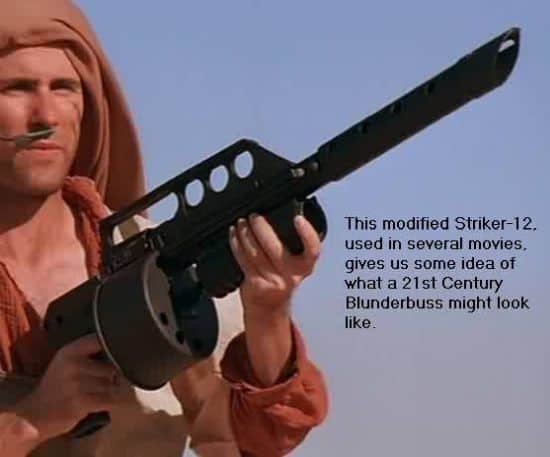By the Author of the Scrapboard : | |
|---|---|
 | Attack, Avoid, Survive: Essential Principles of Self Defence Available in Handy A5 and US Trade Formats. |
 | |
 | Crash Combat Fourth Edition Epub edition Fourth Edition. |
 | |
 | |
| Pellet dia. | No. of Pellets 2 ¾” 12g Shell | No. of Pellets 3” 12g Shell | |
| OOO buck | 0.36” | 8 | 10 |
| OO buck | 0.33” | 9 | 15 |
| No. 4 buck | 0.24” | 27 | 41 |

 When I read about the Payload Rifle one idea that occurred to me was that the same projectiles could be mounted in Dino's shotshell case. On further reflection this would probably not work. The 25mm grenades illustrated here appear to be about 7-8” long, and the fuses probably require a rifled barrel, or at least a faster twist than I envision for the Blunderbuss barrels. How useful would a HE round for the Blunderbuss be?
When I read about the Payload Rifle one idea that occurred to me was that the same projectiles could be mounted in Dino's shotshell case. On further reflection this would probably not work. The 25mm grenades illustrated here appear to be about 7-8” long, and the fuses probably require a rifled barrel, or at least a faster twist than I envision for the Blunderbuss barrels. How useful would a HE round for the Blunderbuss be? I see the Ripley-Blunderbuss mainly as a weapon for improving close to medium range fire-team firepower. The 25-28mm canister round loaded with buckshot, flechettes or Falconet-style darts would do this at close range.
I see the Ripley-Blunderbuss mainly as a weapon for improving close to medium range fire-team firepower. The 25-28mm canister round loaded with buckshot, flechettes or Falconet-style darts would do this at close range.By the Author of the Scrapboard : | |
|---|---|
 | Attack, Avoid, Survive: Essential Principles of Self Defence Available in Handy A5 and US Trade Formats. |
 | |
 | Crash Combat Fourth Edition Epub edition Fourth Edition. |
 | |
 | |